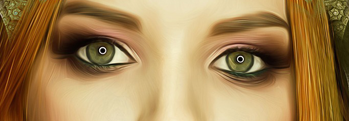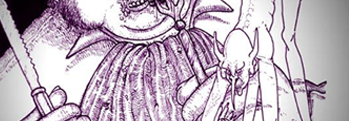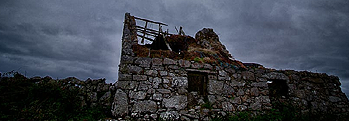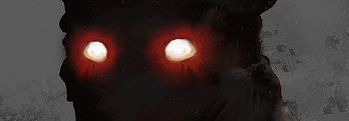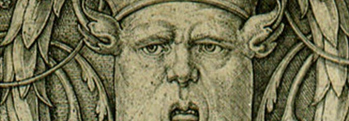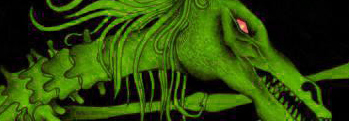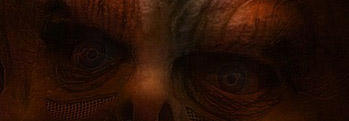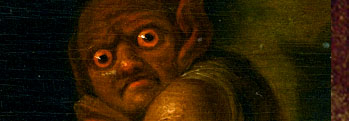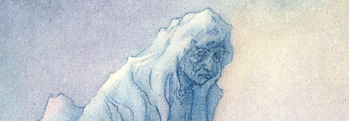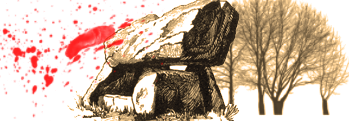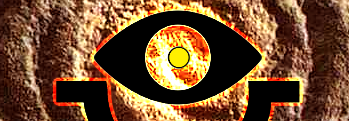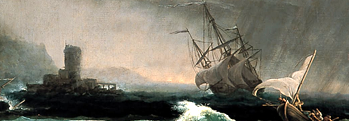Amadan Dubh
Irish and Celtic myths and legends, Irish folklore and Irish fairy tales from Irish Gods and Monsters
Look not upon the Amadan Dubh
In many cultures those that used to be called insane held a special place of reverence, and were treated almost as envoys from another place, or as though they could see something nobody else could, or were dancing to music only they could hear and the rest of us were deaf to. From far-off India and China to more familiar shores people would doff their caps and bow their heads to see one such passing by.
 And so it was in Ireland, where they were called the touched, and it was not meant that they were touched by the moon, unless it be that same moon that shines on our world and the Otherworld, but touched by one of the most powerful fairies of all, the high jester and adviser to the midnight court, the Amadan Dubh, or the Black Fool!
And so it was in Ireland, where they were called the touched, and it was not meant that they were touched by the moon, unless it be that same moon that shines on our world and the Otherworld, but touched by one of the most powerful fairies of all, the high jester and adviser to the midnight court, the Amadan Dubh, or the Black Fool!
He was also called Amadan Briona, which means the greatest fool, or perhaps the grievous fool, and both titles are equally fitting, for the Amadan wasn't one you'd like to meet on a dark night, especially on Midsummer's eve, when he'd sit on the hillsides of fairy mounds and play his reed pipes in a mad jiggling tune, calling the unlucky to him.
His face was terrible to see, and his touch even more so, for it was the Gaoth Sidhe, the fairy wind, and caused all sorts of problems for the person who felt it, but most often a “stroke” which left a person paralysed in one part or all parts of their body.
These are the words of people recorded a century past by Lady Gregory and Yeats, telling of the Amadan Dubh.
A Woman Bringing Oysters from the Strand:
There was a boy, one Rivers, got the touch last June, from the Amadan-na-Briona, the Fool of the Forth, and for that touch there is no cure. It came to the house in the night-time and knocked at the door, and he was in bed and he did not rise to let it in. And it knocked the second time, and even then, if he had answered it, he might have escaped. But when it knocked the third time he fell back on the bed, and one side of him as if dead, and his jaw fell on the pillow.
He knew it was the Amadan-na-Briona did it, but he did not see him-he only felt him. And he used to be running in every place after that and trying to drown himself, and he was in great dread his father would say he was mad, and bring him away to Ballinasloe. He used to be asking me could his father do that to him. He was brought to Ballinasloe after and he died there, and his body was brought back and buried at Drumacoo.
Mrs. Murphy:
Cnoc-na-Briona is full of them, near Cappard. The Amadan-na-Briona is the master of them all, I heard the priest say that.
There was a man of the MacNeills passing by it one night corning back from the bog, and they brought him in, and when he came out next day-God save the mark-his face was turned to his poll. They sent then to Father Jordan, and he turned it right again. The man said they beat him while he was with them, and he saw there a great many of his friends that were dead.
The Spinning Woman:
There are fools among them, and the fools we see like that Amadan at Ballymore go away with them at night. And so do the women fools, that we call lenshees, that means, an ape.
It's true enough there is no cure for the stroke of the Amadan-na-Briona. There was an old man I knew long ago, he had a tape, and he could tell what disease you had with measuring you, and he knew many things. And he said to me one time "What month of the year is the worst?" And I said, "The month of May, of course," "It is not," he said, "but the month of June, for that's the month that the Amadan gives his stroke." They say he looks like any other man, but he's leathan-wide-and not smart. I know a boy one time got a great fright, for a lamb looked over the wall at him, and it with a big beard on it, and he knew it was the Amadan, for it was the month of June. And they brought him to that man I was telling you about, that had the tape. And when he saw him he said "Send for the priest and get a Mass said over him." And so they did, and what would you say but he's living yet, and has a family.
A Seaside Man:
The stroke of the Fool is what there is no cure for; any one that gets that is gone. The Amadan-na-Briona we call him. It's said they are mostly good neighbours. I suppose the reason of the Amadan being wicked is he not having his wits, he strikes out at all he meets.
A Clare Man:
They, the other sort of people, might be passing you close and they might touch you; but any one that gets the touch of the Amadan-na-briona is done for. And it's true enough that it's in the month of June he's most likely to give the touch. I knew one that got it, and told me about it himself.
He was a boy I knew well, and he told me that one night a gentleman came to him, that had been his landlord, and that was dead. And he told him to come along with him, for he wanted to fight another man. And when he went he found two great troops of them, and the other troop had a living man with them too, and he was put to fight him. And they had a great fight and at last he got the better of the other man, and then the troop on his side gave a great shout, and he was left home again.
But about three years after that he was cutting bushes in a wood, and he saw the Amadan coming at him. He had a big vessel in his arms, and it shining, so that the boy could see nothing else, but he put it behind his back then, and came running; and he said he looked wide and wild, like the side of a hill.
And the boy ran, and the Amadan threw the vessel after him, and it broke with a great noise, and whatever came out of it, his head was gone then and there. He lived for a while after and used to be telling us many things, but his wits were gone. He thought they mightn't have liked him to beat the other man, and he used to be afraid something would come on him.
Mrs. Staunton:
A friend of mine saw the Amadan one time in Poul-na-shionac, low-sized and very wide, and with a big hat on him, very high, and he'd make shoes for you if you could get a hold of him. But there are some say "No, that is not the Amadan-na-Briona, that is the leprechaun."
An Old Woman:
The Amadan-na-Briona is a bad one to meet. If you don't say, "The Lord be between us and harm," when you meet him, you are gone for ever and always. What does he look like? I suppose like any fool in a house-a sort of a clown.
A Man near Athenry:
Biddy Early could cure nearly all things, but she said that the only thing that she could do no cure for was the touch of the Amadan.
Another:
Biddy Early couldn't do nothing for the touch of the Amadan, because its power was greater than hers.
In the Workhouse:
The Amadan-na-Briona, he changes his shape every two days. Sometimes he comes like a youngster, and then he'll come like the worst of beasts. Trying to give the touch he used to be. I heard it said of late that he was shot, but I think myself it would be hard to shoot him.
Ned Meehan of Killinane:
The Amadan is the worst; I saw him myself one time, and I'd be swept if I didn't make away on the moment. It was on a racecourse at Ballybrit, and no one there but myself, and I sitting with my back to the wall and smoking my pipe. And all at once the Amadan was all around me, in every place, and I ran and got out of the field or I'd be swept. And I saw others of them in the field; it was full of them, red scarfs they had on them.
I came home as quick as I could, and I didn't get over the fright for a long time, but there he was all about me.
Meehan's wife says: I remember you well coming in that night, and you trembling with the fright you got. And you told me the appearance he had, like a jockey he was, on a grey horse.
"That is true indeed," says Ned, and he goes on:
And one night I was up in that field beyond, watching sheep that were near their time to drop, and I saw a light moving through the fields beside me, and down the road and no one with it. It stopped for a while where the water is and went on again.
And there was a woman in Ballygra the same night heard the coach-a-baur passing, and she not hearing at all about the lights I saw.
A Man at Kilcolgan:
Father Callaghan that used to be in Esker was able to do great cures; he could cure even a man that had met the Amadan-na-Briona. But to meet the Amadan is to be in prison for ever.
Below on the map is marked the racecourse at Ballybrit, which is a fine place to visit in the broad light of day, but ware and watch should you walk near it at night!
More Irish Gods and Monsters
It is during the darkest winter nights that we sit inside our houses and listen to the wind hammering at our windows and doors, as if it had a mind and will of its own – as if it wished to do us harm! The old people of Ireland believed that was the literal truth, that there were demons of the air, or demna aeóir thronging about the ... [more]
No tale of ancient Ireland could be complete without mentioning the Fomorians, dreaded foes of the Tuatha Dé Danann and all who came to conquer Ireland. The meaning of their name is debated even today, although most agree that the first part, fó, means “from below” or “nether” and the latter part means “t ... [more]
The dragons of Ireland were not like the dragons of other places, since they did not have wings or often even claws, and only rarely did they breathe fire, if at all! The were called the Ollphéisteanna, which means “great worms” or “mighty reptiles”, the terrible serpents of the world that was. The greatest among t ... [more]
It's well known that the people of Ireland are gifted in poetry, music, writing and the arts, and many have to come to these shores to admire these works. But there is one who moves through the misty glens and dappled glades of Ireland and it is the poets who whisper to her in the darkest hours of the night, hoping for an answer! This fairy ... [more]
In Ireland of old, the Alp-Luachra was one of the most dreaded of all the fairy folk. It also went by the name of Joint-eater, Just-halver, Art-Luachra, Airc-Luachra, and Doichi-Luachair. This creature made its abode in Irish streams and rivers and any place where green life grew from water. Outside of a person it was not much to look at, being ... [more]
Among all the fairy folk who wander the mists and glimmerings of Irish folklore, there are few as feared as the Fear Gorta, whose name means “the Hungry Man”. When hunger stalks the land, it does so as a hound following the footsteps of the Fear Gorta, a solitary, gaunt and masterless spirit of emaciated appearance. Now this fairy is ... [more]
One of the great terrors of ancient – and not so ancient! – Ireland was the Cú Sidhe, or the hound of the Sidhe. This monstrous beast was known in all of the lands once ruled by the Gael, being called the cù-sìth in Scotland and the Cŵn Annwn in Wales. They were also known as the Coinn Iotair, Hounds of Rage, whi ... [more]
A name which echoes through many ancient Irish myths and legends is that of the spirit of the oceans, Manannán mac Lir. Was he a Gaelic god and father of gods, a powerful king of old, first among the Tuatha De Danann, a title for a cult of secretive mystics or a Lord of the Otherworld? Perhaps all of these and more, or none. The earliest ... [more]
Across the northern parts of Ireland and Scotland people sometimes whisper of a terrifying spirit that can sometimes be seen before a big storm hits, the one they call the Storm Hag, or the Cailleach. She is known as the queen of winter, and her destructive power is most often witnessed at the end of winter, when her power is fading. The people ... [more]
Whispered across misty ages from times long gone are stories of the Cailleach, one of the ancient goddesses of the first people to walk in Ireland, queen of the mighty glaciers that once clenched the land in their frozen grip. Many tales are told of the old hag, but fewer speak of her consort, the Bodach! His name means “the old man” ... [more]
When Saint Patrick banished the serpents from Ireland, there was one who was overlooked, perhaps because he slumbered or was abroad himself, and that one was called Lig na Paiste, or the “Last Great Reptile”. Soon after Saint Patrick passed away, he made his presence known as he was known of old to the people of Owenreagh! A giant se ... [more]
Throughout the lands where Gaelic was spoken, the legend of the water horse was whispered by many a fireside, or sometimes told in a hurry by someone running the other direction! There are many lakes in Ireland, and most of them aren't very large, but they run still, dark and deep. The Each-Uisce, as the water horse or horse-eel was known in ... [more]
Of all the different kinds of goblins that haunted the lonely places of Ireland in days of old, air-demons were most dreaded by the people. They lived among clouds, and mists, and rocks, and they hated the human race with the utmost malignity. In those times lived in the north of Desmond (the present county of Cork) a man man named Fergus O'Mar ... [more]
In many cultures those that used to be called insane held a special place of reverence, and were treated almost as envoys from another place, or as though they could see something nobody else could, or were dancing to music only they could hear and the rest of us were deaf to. From far-off India and China to more familiar shores people would doff t ... [more]
Ancient Ireland was said by some to have been plagued by a particularly large and fierce breed of wolf, and men would sometimes go to war with them, or call them to war alongside heroes and champions! They would even make so bold as to attack villages and towns, and a great pack of them assailed Coleraine in the year 1650. To battle these fierce ... [more]
An Cailleach or the veiled woman is among the most ancient deities venerated in Ireland, she whose realm lies in the ice and cold of winter. Once it was said that she ruled all the world, when the green things slept for untold aeons beneath her thick icy cloak, until she was given cause for great sorrow and wept floods of tears across the land, her ... [more]
While most people nowadays believe fairies to be gentle creatures, prone to mischief perhaps and capricious by their natures yet well intended for all that, in Ireland they have a more sinister reputation. Some say, and some still believe, that the fairies will take small children and young people, leaving in their place creatures known as changeli ... [more]
They do say that good things come in small parcels, but often forget to add that not all small parcels are filled with good things! And so it was in the little village of Slaughtaverty in the distant past, ruled as it was by a fearsome dwarf-tyrant known as Abhartach. Stature and size were much prized in ancient Ireland, as well they might be fo ... [more]
In ancient times, even before the Tuatha De Dannan and the Fir Bolg went to war over the green land of Ireland, the land was ruled by a powerful sorcerous race called the Fomors. Warped and strange they were in appearance, some say dark of skin while others claim they dwelt at the bottom of deep lakes and in the turbulent depths of the ocean' ... [more]
The Pooka or Puca is one of the most ancient fairy creatures of Ireland, and is known further abroad as well, called Puck or Pook. In some places he is feared and in others respected. He can take many shapes, most commonly that of a wild horse wrapped in chains with sulfurous or blazing crimson eyes - the night mare - a huge dog, a raging bull, a h ... [more]
The Banshee or woman of the fairy folk as she is known in Ireland has many names, the Little Washerwoman, Hag of the Mist and the Hag of the Black Head. She takes three forms, that of a young and comely maiden, a matron of full and generous figure, or that of a wretched old crone, and is dressed in red or white or as the occasion calls for it, in t ... [more]
Crom Cruach was one of the old gods of Ireland, one of the few mentioned as a god in the Annals of the Four Masters, an ancient Irish codex telling of the times before Christianity came to Ireland. His name may have many meanings, but he was most commonly known to the people as Crom Dubh, or the crouching darkness. His worshippers are said to have ... [more]
Old Jack Doherty was a kindly and good natured sort of fellow, as well he might be for he had chosen to live in a strange and desolate part of the country, by a coast of jagged rocks and sucking tides. And why might that be cause for merriment, you may ask? Well, it was many's the night and many's the storm that blew an unfortunate ship too ... [more]
Of all the wonders and terrors in Irish folklore there are few quite so terrifying as the Sluagh. Tales were told of their wild hunt long before the coming of Christianity to Ireland, and even today old folk in the countryside will keep the windows on the west side of the house fastened tight at all times, but most especially during wakes or if som ... [more]
The Red Thirst, the Dearg Due, was these thousand years gone by a young maiden of surpassing fairness. Bards sang songs of her skin as fair as springtime snow and her lips as red as rubies in the light of the setting sun, men came from far and wide to seek her hand in marriage. And yet pretty as she was, he true beauty shone from within, as kindly ... [more]







